May 16, 2008
Air Date: May 16, 2008
FULL SHOW
SEGMENTS
Threatened Bear May Hold Health Secrets
View the page for this story
The Bush administration has acknowledged that polar bear habitat is diminishing because of climate change and has declared the bear a threatened species. Host Bruce Gellerman talks with Dr. Aaron Bernstein, co-editor of the new book “Sustaining Life: How Human Health Depends on Biodiversity,” who says studying polar bears in their natural environment could help us understand diseases like diabetes and osteoporosis. (04:00)
Food Profiteering
View the page for this story
With the higher costs of staple foods like corn and wheat some are making record profits. Host Bruce Gellerman talks with The Economist’s John Parker about what’s causing the global food crisis and who benefits from high prices. (06:20)
Senator McCain’s Climate Record
/ Jeff YoungView the page for this story
Republican presidential contender John McCain made it clear he's not like President George Bush when it comes to global warming - the candidaten has pledged to limit greenhouse gas emissions. But critics ask why Senator McCain won't do more to support renewable energy. Living on Earth’s Washington correspondent Jeff Young reports from Washington. (08:00)
Galapagos Wind
/ Erico GuizzoView the page for this story
Seven years after a major oil spill in the Galapagos, the government of Ecuador has held true to its word to cut down on the number of diesel imports to the archipelago. The country just inaugurated its first wind farm on San Cristobal island in the Galapagos, and it’s one of the world’s largest wind-diesel hybrids. Spectrum Radio’s Erico Guizzo visited the San Cristobal Wind Project and has our report. (07:00)
Cool Fix for a Hot Planet
View the page for this story
A listener from Canton, Ohio offers his suggestion to fight climate change at home: wrap your refrigerator. (02:15)
Cargo, Clean and Quiet
/ Ingrid LobetView the page for this story
Imagine a heavy-duty truck, fully electric, that can haul 60 thousand pounds for 30 miles on one charge. The seaport of Los Angeles is about to receive 25 electric port vehicles, and officials expect them to catch on at ports worldwide. Living on Earth’s Ingrid Lobet reports from Los Angeles. ()
Electric Dreams Could Come True
View the page for this story
Nissan pledges to build a zero emissions electric car by 2010. Host Bruce Gellerman talks with John O’Dell, senior editor of the website Green Car Advisor, about what the car will look like and how and when we might see a fleet of electric automobiles. (05:00)
Michael Recycle
View the page for this story
Shooting through the sky with a cooking-pot hat and tin can elbow pads, super hero Michael Recycle has a mission: to get kids recycling. Host Bruce Gellerman turns to nine-year-old Anna Carton-Smith for a review of the new book, “Michael Recycle” by Ellie Bethel. (05:10)
This week's EarthEar selection
listen /
download
Sounds from a dripping-wet Brazilian forest.
Show Credits and Funders
Show Transcript
HOST: Bruce Gellerman
GUESTS: Aaron Bernstein, Anna Carton-Smith, Steve McArthur, John O’Dell, John Parker
REPORTERS: Erico Guizzo, Ingrid Lobet, Jeff Young
[THEME]
GELLERMAN: From Public Radio International – this is Living on Earth.
[THEME]
GELLERMAN: I’m Bruce Gellerman. The Bush Administration declares the polar bear’s only threatened – not endangered. But medical scientists say the bear’s something else.
BERNSTEIN: The polar bear is a metabolic marvel: it’s able to do things that we could only dream of, and one of the things that’s particularly valuable to humans is that when the female bear’s in the winter den, they put on tremendous amounts of blubber, and yet they don’t develop diabetes.
GELLERMAN: Also John McCain has plans to clean up greenhouse gases, and Michael Recycle, the green caped crusader, has plans to get kids to clean up the environment.
CARTON-SMITH: Well, I think that this book is important to maybe, probably, people who don’t recycle as much, and it can show them that you should start recycling to make it better for the world!
GELLERMAN: We meet Michael Recycle – these stories and more this week on Living on Earth. Stick around!
ANNOUNCER: Support for Living on Earth comes from the National Science Foundation and Stonyfield Farm.
Threatened Bear May Hold Health Secrets
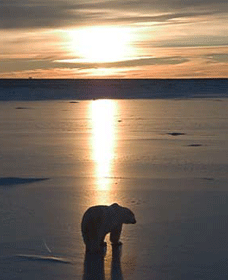
(Photo: Lee Foster)
[RETURN THEME]
GELLERMAN: From the Jennifer and Ted Stanley Studios in Somerville, Massachusetts – this is Living on Earth. I’m Bruce Gellerman, in for Steve Curwood.
The polar bear is officially on thin ice. After fighting lawsuits by conservation groups for years, the U.S. Interior Department has reluctantly agreed to add the polar bear to the government’s list of threatened animals under the Endangered Species Act. The bears are threatened by the loss of an important part of their habitat: sea ice. Global warming is melting the ice far faster than expected, said Interior Secretary Dirk Kempthorne as he announced his long awaited decision.
KEMPTHORNE: When we’ve looked at what is actually happening in the arctic, we have found considerably less sea ice than the models are even projecting. This, in my judgment, makes the polar bear a threatened species, one likely to become in danger of extinction in the foreseeable future.
GELLERMAN: But even as Kempthorne identified global warming as a threat, the Secretary made it clear that the polar bear listing – under the Endangered Species Act – would do nothing to limit global warming gases.
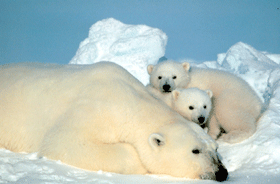
(Photo: Steve Amstrup/U.S. Fish and Wildlife Service)
GELLERMAN: In an unusual move, Kempthorne specifically exempted the threat to polar bears from being linked to greenhouse gases. The move allows oil and gas companies to explore and drill in polar bear habitat. Environmentalists say Kempthorne’s interpretation of the law turns his decision into little more than a symbolic act. Susan Casey Lefkowitz is an attorney with the Natural Resources Defense Council. It’s one of the groups that sued to force the Bush administration to act on behalf of polar bears.
CASEY LEFKOWITZ: This decision seems to be so full of loopholes that we’re actually wondering how much it’s actually going to protect the polar bear. Instead they seemed to talk about business as usual, especially with the oil and gas industry, and that just does not seem compatible with the protection of the polar bear.
GELLERMAN: Environmentalists aren’t the only critics of Kempthorne’s decision. Property-rights advocates and oil interests aren’t happy either, and say they’ll file lawsuits to overturn the Interior Department’s ruling. But the polar bear is not just an icon of the environmental movement. It could play a critical role in human medical research.
Aaron Bernstein of Harvard Medical School is co-editor of the soon to be published book “Sustaining Life: How Human Health Depends on Biodiversity.”
BERNSTEIN: The polar bear is a metabolic marvel. It’s able to do things that we could only dream of. And one of the things that’s particularly valuable to humans is that when the female bear’s in the winter den, they put on tremendous amounts of blubber, and yet they don’t develop diabetes. And we need to sort out how they do that, because we have an epidemic of Type II diabetes related to obesity in our country. And when humans become obese they become at increased risk of developing type two diabetes. Polar bears, however, somehow seem to escape that fate, but we really don’t understand how.

The Bush administration delivered its long-awaited decision on how to protect the polar bear by listing it as "threatened" under the Endangered Species Act. (Photo: Lee Foster)
BERNSTEIN: In a sense yes, except that we have to study them in the wild, because the only way they’re able to put on that amount of weight is by eating seal blubber, in fact gorging on it – they can eat a hundred pounds of it at a time – so having them in a lab actually won’t help us learn how they do it.
GELLERMAN: Why polar bears? I mean, a polar bear’s not like a human.
BERNSTEIN: Well it turns out that we’re a lot more related to a lot of things than some of us would like to believe. You know, the Earth is an extraordinary place with extraordinarily diverse life. That life has adapted to all of these extraordinary places that creatures live, and it is those adaptations that are incredibly valuable to us as humans because they can help us solve some of the most difficult medical problems we face.
GELLERMAN: I was reading that polar bears might help us solve osteoporosis.
BERNSTEIN: Denning bears, like polar bears, females in particular, spend the winter months not being very active while they’re denning, and during this time they don’t lose any bone. If a human spent months without moving, they would lose a quarter or a third of their bone, leading to a condition known as osteoporosis. Somehow denning bears seem to avoid that fate. Osteoporosis is also a major public health problem in the country. These creatures have potentially invaluable information to helping us better treat some of the most widespread diseases in our population, in the United States, but worldwide, and to lose them would be an act of perhaps unparalleled folly.
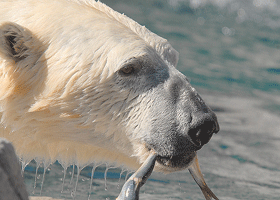
Scientist Aaron Bernstein says like people polar bears gain a lot of weight when they den, but - unlike people - don’t get diabetes. (Photo: Kristi Harper)
BERNSTEIN: There are a total of five species of bear that are currently listed as threatened with endangered. We really, frankly, don’t know what secrets these species may hold. But the reality is that the closer we look at the natural world and the adaptations that are present there, the more we learn about ourselves and how we might understand how our bodies work and how we might better treat them when there’s illness.
GELLERMAN: Well, Dr. Bernstein, I want to thank you very much.
BERNSTEIN: Thanks so much for having me.
GELLERMAN: Aaron Bernstein is co-editor of the book “Sustaining Life: How Human Health Depends on Biodiversity.”
Related link:
To learn more about Aaron Bernstein's book, click here
Food Profiteering

The hungry reach for food distributed at a religious shrine in a village in Sindh Province, Pakistan. (Photo: Raja Islam)
GELLERMAN: Here’s a new government statistic that confirms what you already know too well: the price of food is going through the roof. Of course that’s not the technical term. According to federal statisticians, food costs five percent more than a year ago, and is increasing at a rate we haven’t seen in two decades.
And it’s worse for developing countries. The UN says thirty-seven nations are in urgent need of food, but can’t afford it, triggering fears of even more food riots like those that have rocked Egypt, Bangladesh, Somalia and Haiti. And yet, as prices soar, so do corporate profits – for some companies on the food chain. To chew over food prices, we turn to an economist – indeed, The Economist. On the line from London is The Economist magazine’s globalization expert, John Parker. John, welcome to Living on Earth,
PARKER: Hi. Thank you for inviting me.
GELLERMAN: You know, we’ve heard about a lot of factors being blamed for the escalation in food prices – the weather, biofuels, you know, India, China eating more meat, weak dollar, high oil. What do you think is driving up the price of food?
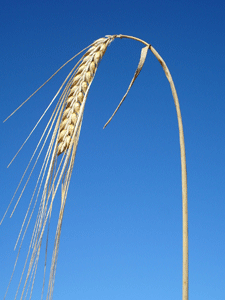
Shortages of staples grains such as wheat, rice, and corn have led to riots in developing countries and record profits for traders and farmers. (Photo: www.thisbluedot.net)
GELLERMAN: Well, why would that be? I mean, we’ve always been producing biofuels. I did stories about, you know, ethanol being produced from corn thirty years ago.
PARKER: Yeah, sure. But in 2005 the U.S. made the biofuels policy a lot more generous, and much more American maize, American corn, has gone to ethanol in the last couple of years. Now it’s something like a third of the crop goes there. Remember, you know, American maize used to be one of the world’s great cereal crops. People around the world used to eat American maize. Now you’re consuming in the form of ethanol as much as you’re exporting. That never used to be the case.
GELLERMAN: And India and China – are they really eating that much more meat?
PARKER: Well yes, I mean, they’ve been eating a little bit more over 20, 30 years, and it, you know, it mounts up. China eats about – per head this is – about three times as much pork, which is the main meat, as they did in 1980.
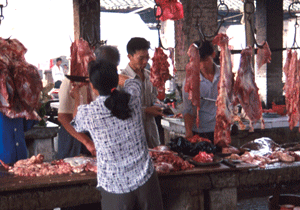
A meat market in Guangxi Province. The Economist magazine reporter John Parker says the growing consumption of meat in China and India is helping push global food prices up. (Photo: Korey Egge Marquez)
GELLERMAN: So the U.S. taxpayer’s getting a double-whammy here. That is, they’re paying the subsidies for the ethanol production, and they’re paying higher prices at the supermarket for food.
PARKER: Well they’re not the only ones of course. The Europeans have been specializing in this particular piece of insanity for years and years and years. I mean we, in Europe, subsidize our food even more than you guys do. So you are getting hit twice over, and, sort of, so are most other rich countries. And what’s really particularly nuts is that the European countries, particularly France and Germany, are currently reacting by saying, uh oh! High prices for food. We’ve got to subsidize our farmers more.
GELLERMAN: So it sounds to me that you’re saying there are structural problems here, and cultural changes and economic changes, that aren’t gonna go away. This is not a bubble.
PARKER: I don’t think this is a bubble. Partly for those long-run changes I was talking about, you know, the Chinese and Indians and others eating more meat. The end of cheap food, which we had for 40 years, I think is over, and the world will adjust slowly.
GELLERMAN: What about the people that are making money out of all this? I was looking at the, Monsanto, Cargill, Archer Daniels Midlands – they’re making windfall profits! I mean extraordinarily high profit margins.
PARKER: Yeah, they are, but look – for me, the most important people who are making money out of this are not kind of rich, American multinationals; it’s poor peasant farmers. And if you look back over 50 years, these guys have really had a rough time. Essentially we in the West – in Europe and in the U.S. – have been kind of dumping our food surpluses on the rest of the world, and they haven’t been able to make much of a living.

The hungry reach for food distributed at a religious shrine in a village in Sindh Province, Pakistan. While many in developing countries battle famine amid rising global food prices, some grain dealers are reaping record profits. (Photo: Raja Islam)
GELLERMAN: If the price of oil were to come down, would that help things?
PARKER: It would a little bit, because oil’s a major component of fertilizers, and fertilizers are, you know, really, really important as an input to farmers. But I don’t think it would change the basic, sort of supply-demand balance very quickly, so I would expect it to make a marginal difference, but not, you know, it wouldn’t halve the price of wheat or something like that.
GELLERMAN: John, have you been to the supermarket lately?
PARKER: I go every weekend.
GELLERMAN: Yeah, well, I went this weekend and I got sticker shock!
PARKER: But just imagine – I don’t know how much of your weekly budget goes on food, but for me it’s not that much. Imagine if half of your salary went on food – this happens in poor countries. Imagine the sticker shock they’re getting.
GELLERMAN: Well, you work for The Economist, but I’m reading your rival magazine here, Time, a recent issue. Since 2003, they say Wonder Bread’s up seventy-four percent, pork chops up one hundred twenty-four percent, rib-eye steaks sixty-four percent, bananas forty-one percent. Can we expect prices to keep on going up in the near future?
PARKER: If I knew that I would be making large sums of money on the futures markets. But my guess is that prices will begin to stabilize later on this year. The truth of the matter is that almost everyone, including me, was surprised when prices continued to rise in the first half of this year. So I’m pretty reluctant to forecast an end to these price rises soon.
GELLERMAN: Boy this is complicated stuff, John, I’m glad we have an economist to help us sort through it.
PARKER: (laughs) Thanks very much for inviting me.
GELLERMAN: Speaking to us from London John Parker, the globalization expert for the British magazine The Economist.
Related link:
The Economist magazine on the food crisis
[MUSIC: Jacob Fred Jazz Odyssey “Teather Ball Triumph” from ‘Lil Tae Rides Again’ (Hyena – 2008)]
GELLERMAN: Coming up – John McCain talks the talk about climate change. Straight ahead on Living on Earth.
Senator McCain’s Climate Record
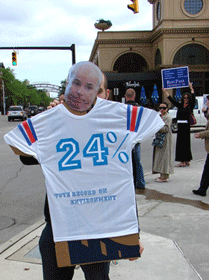
Despite John McCain’s pro-environment rhetoric, protester Bret Thompson thinks McCain’s voting record on the environment merits “24 %.” (Photo: Liza Alwes)
GELLERMAN: It’s Living on Earth. I’m Bruce Gellerman. On the campaign trail, Republican presidential hopeful John McCain has been talking the talk about energy and environmental issues, and recently putting more and more distance between himself and President Bush on climate change. On the stump, McCain talks passionately about global warming, but is he walking the walk? Living on Earth’s Jeff Young has been investigating McCain’s campaign rhetoric and his voting record in the Senate.
YOUNG: When Senator John McCain focuses on climate change, his campaign managers like to put him in a photo-op friendly setting – like a solar equipment company or, in this case, the Vestas wind turbine facility in Portland, Oregon.
SOBY: Please say hello to Senator McCain. Thank you.
[APPLAUSE]
YOUNG: McCain’s been a leader on climate change. Five years ago he authored the first major carbon cap bill to reach the Senate floor. And he brought climate scientists to the capitol in nearly a dozen congressional hearings. Now he wants independent-minded voters in battleground states like Oregon to know that on global warming, he’s no George W. Bush.
MCCAIN: Good stewardship, prudence and simple common sense demand – demand that we act to meet the challenge and act quickly. I will not shirk the mantle of leadership that the United States bears. I will not permit eight long years to pass without serious action on serious challenges.
YOUNG: But as McCain distances himself from Bush, he also needs to reassure Republicans who remain concerned about the economic effects of a cap on carbon emissions. McCain says his cap and trade approach will work with the free market to encourage innovation and investment in cleaner energy sources. And he would allow CO2-intensive industries to make generous use of carbon offsets: things like paying farmers to capture the methane from animal enclosures. McCain says economists agree with him that offsets can keep the price of carbon emissions – and thus the price of energy – from rising sharply.
MCAIN: We want to turn the American economy toward cleaner and safer energy sources, and you can’t achieve that by imposing costs that the American economy cannot sustain.
YOUNG: McCain says he will use diplomacy and trade to try to bring China into an international agreement on greenhouse gases. And in another break from Bush policy, he says he would not allow China’s inaction to prevent the U.S. from moving ahead.
MCCAIN: If the efforts to negotiate an international solution that includes China and India do not succeed, we still have an obligation to act.
YOUNG: McCain’s targets for greenhouse gas reductions would have the US return to its 1990 level of emissions by the year 2020. By mid century, the U.S. would be 60 percent below that level. McCain policy advisor Doug Holtz-Eakin says it’s a plan designed to strike a balance between climate science and political science.
HOLTZ-EAKIN: So in an effort to make sure we get something done, he’s tailored his proposal to be good on the science, good on the economy and hopefully allow us to have some leadership on this issue in the world.
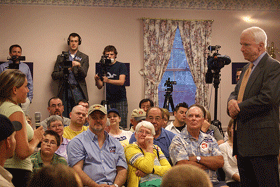
McCain fields a question about global warming while campaigning for the Republican primary in Merrimack, New Hampshire. (Photo: Marc Nozell, under Creative Commons license)
CLAUSSEN: I think he was good on the early date, 2005 levels in 2012, as aggressive as we have seen in the United States. Yes, his 60 percent is less than some of the 80 percents, and we probably do need 80 percent, but there will be lots of time to come back and actually redo that final number as we learn more and more about the science.
YOUNG: Claussen gives McCain’s plan high marks. But other environmentalists are critical, especially when it comes to McCain’s support for nuclear power. McCain says he wants the government to help the nuclear industry build 20 new nuclear reactors by the end of his first term as president. League of Conservation Voters president Gene Karpinski says that’s the wrong place to put scarce government dollars.
KARPINSKI: Well you know one of the ironies is he did his event at a wind power facility, and he’s unfortunately consistently opposed tax credits for wind power. On the other hand, he supports tax subsidies for a 50 year-old industry that doesn’t know what to do with its waste: the nuclear power industry. So that really makes no sense.
YOUNG: Karpinski’s group gives McCain a weak 24 percent rating for his congressional votes on environmental issues. McCain opposed a renewable electricity standard to require utilities to generate ten percent of their power through wind, solar or other clean energy sources. And more recently, McCain missed a chance to deliver the one thing the renewable energy companies need most. Let’s go back to Senator McCain’s speech at the Vestas facility.
SOBY: Wind is modern energy, and Vestas is number one in modern energy.
YOUNG: Just before Vestas America president Jens Soby introduced the senator, he made this appeal for support.
SOBY: We need a long-term energy policy, and we need a short-term extension of the production tax credit. Please say hello…

Despite John McCain’s pro-environment rhetoric, protester Bret Thompson thinks McCain’s voting record on the environment merits “24 %.” (Photo: Liza Alwes)
WEISS: Last December there was a vote to shift about two billion dollars a year in tax breaks for big oil, and invest them instead in clean, renewable energy like wind, solar and geothermal power. That vote failed by one vote. The only person who didn’t vote was John McCain.
YOUNG: McCain advisor Holtz-Eakin blames the busy presidential campaign schedule.
HOLTZ EAKIN: He had campaign commitments; he was unable to attend the vote, and you know, that’s one of many votes where he’s been asked, you know, what would have happened. You can’t relive history.
YOUNG: As it turns out, McCain had a chance to relive that vote just two months later. In February, the same energy tax proposal came up again. Again, just one vote would have made the difference, and again McCain was absent. On the day of that vote McCain was in Washington – about a 15-minute drive from the capitol dome – speaking to the conservative political action conference. Well since then, he’s devoted more of his time to campaign fundraising. Sheila Krumholz tracks campaign money at the non-partisan center for responsive politics, which runs the website Open Secrets. Krumholz says McCain has had remarkable success in recent months getting money from the energy sector, including oil and gas.
KRUMHOLZ: John McCain is now the number one recipient of oil and gas money in this cycle, with 515,000 dollars so far.
YOUNG: She says that’s probably not all the oil and gas money McCain’s getting. Like most campaigns, McCain uses so-called money bundlers to raise cash. These influential people pledge to raise a certain amount from acquaintances. McCain’s bundlers include some big names from big oil, like Houston oilman and former commerce secretary Bob Mosbacher, Kit Moncrief of the Moncrief Oil family, and Texas oil lobbyist Gaylord Hughey, Jr. Together, those three have pledged to raise nearly half a million dollars. Krumholz says that might clash with McCain’s maverick image.
KRUMHOLZ: There will be something of a rhetorical dance explaining both his platform, which has been so stridently opposed to special access for special interests, at the same time that he’s collecting more and more money from these very interests.
YOUNG: There’s no doubt McCain’s been a climate crusader, and his campaign insists he remains committed to the cause. But a weak voting record on clean energy and his newfound friends in Big Oil cloud that image, and could make it tougher for McCain to win over the climate-conscious voters he’s seeking. For Living on Earth, I’m Jeff Young in Washington.
GELLERMAN: To hear more of Jeff’s interview with Senator McCain’s climate adviser, check out our website at l-o-e dot o-r-g.
Related links:
- ** WEB EXTRA** To hear a longer version of Living on Earth's interview with Doug Holtz-Eakin, Senator John McCain's climate adviser, click here
- McCain’s platform on climate change
- Open Secrets on McCain’s campaign contributions
- League of Conservation Voters on McCain’s record
[MUSIC: Bill Frisell “Struggle” from ‘History, Mystery’ (Nonesuch – 2008)]
Galapagos Wind
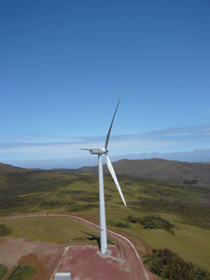
One of San Cristobal wind project's three turbines; together they supply half of the islands’ energy. (Courtesy of San Cristobal Wind Project)
GELLERMAN: The Galapagos is a wind-swept archipelago, famous for inspiring Charles Darwin’s theory of evolution. Now even the wind there is evolving, thanks to a new generation of wind power technology. On the island of San Cristobal, you’ll find a new breed of wind turbine that supplies half of the island’s electricity. Spectrum Radio’s Erico Guizzo traveled to the Galapagos and brought back our report.
[BOAT ENGINE HUMMING]
GUIZZO: San Cristóbal is part of a group of small islands in the Pacific that form one of the most exquisite places on earth: the Galapagos archipelago. Every year, more than one hundred thousand tourists come to the Galapagos to get close to its extraordinary fauna: to snorkel with hammerhead sharks, hang out with giant tortoises, or bask on the beach with sea lions.
[SEA LIONS BARKING ON THE BEACH]
GUIZZO: Charles Darwin visited the Galapagos in 1835. The unique creatures he found here captured his imagination and helped him realize that species evolve by means of natural selection. Nature loving visitors now flock to the islands in hopes of seeing what Darwin saw. But today the Galapagos, located about seven hundred miles off Ecuador, is a very different place. Tourism has increased rapidly, and so has the local population, which now is more than twenty thousand. There are also lots of hotels, shops, restaurants and vehicles.
[MOTORCYCLE ENGINE STARTS UP; KIDS TALKING]
GUIZZO: The tourism and population boom brought a higher demand for electricity. Until recently, the islands relied entirely on diesel generators. The fuel for the generators, and also for boats and vehicles, arrives by oil tanker from mainland Ecuador. Seven years ago, a tanker ran aground and spilled 150,000 gallons of fuel into San Cristóbal’s harbor. Since then, the government of Ecuador intensified efforts to free the Galapagos from fossil fuels. The government teamed up with the United Nations Development Program and the e8, an international consortium of electricity companies, to launch the San Cristóbal Wind Project.
[WIND BLOWING]
TOLAN: This project is called a high penetration wind-diesel hybrid system.
GUIZZO: Jim Tolan is an American engineer and one of the project managers. He says that the goal of the ten million dollar project is to supply half the island’s electricity, on average, with a two point four megawatt wind farm.
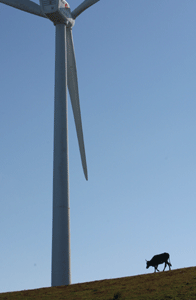
(Photo: Diego Añazco)
TOLAN: In the high wind periods, we might actually be putting eighty percent of the grid energy from wind; it’s a very high percentage.
[TURBINE BLADES WHIRRING]
GUIZZO: The three wind turbines perch atop a hill on the highlands of San Cristóbal, ten miles from town. The steel towers stand as tall as fifteen storey buildings and hold three-bladed rotors. Through the dense fog, it’s difficult to make out the blades, each about the length of a Jumbo 747 wing.
[TURBINES WHIRRING]
GUIZZO: Tolan leads me through a small door into turbine number one. We put on safety harnesses and hook them to a steel cable to climb a narrow ladder that stretches all the way to the top of the tower.
[HARNESSES CLANKING ON STEEL CABLE]
GUIZZO: Inside this giant white walled tube, with the fluorescent lights flickering and electronic equipment beeping, it's like being in a spaceship.
[ELECTRONIC BEEPING]
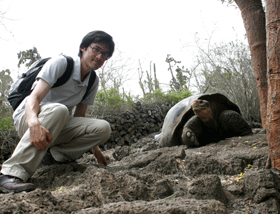
Reporter Erico Guizzo communes with a tortoise. (Photo: Erico Guizzo)
The San Cristobal wind project presented many technical and logistical hurdles to Tolan and his team, including how to bring construction equipment and materials to this tiny island. But in the end, what proved more challenging were the environmental aspects of the project.
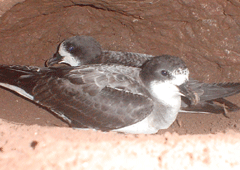
The San Cristobal wind project team had to show that their wind farm would not disturb the nesting grounds of the endangered seabird, the Galapagos petrel. (Courtesy of San Cristobal Wind Project)
Eventually studies concluded that the turbines presented little threat to the petrel and that transmission lines should be buried to minimize obstructions to the birds’ flight path. San Cristóbal residents soon were on board with the project, and are now proud to be the first place in the Galapagos, and all of Ecuador, to use wind power. Patricio Andrade heads Elecgalapagos, the publicly owned utility. He says the new system is a big step for the archipelago.
[ANDRADE SPEAKING SPANISH]
TRANSLATION VOICE OVER: Many years ago, we had to use oil lamps here, in the rural areas for example. Now we will have a hybrid wind diesel system! Twenty, thirty years ago, at least for me, this was not something I would even dream of!
[FOOTSTEPS ON GRAVELLY TRAIL; BIRDSONG]
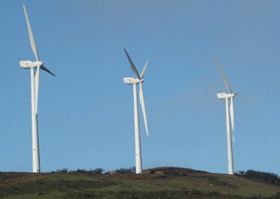
(Courtesy of San Cristobal Wind Project)
[SEA LIONS BARKING; BIRDSONG]
GUIZZO: For Living on Earth, I’m Erico Guizzo.
GELLERMAN: Our story about the Galapagos wind farm comes to us courtesy of Spectrum Radio, the broadcast edition of IEEE Spectrum, the magazine of technology insiders.
Related link:
Erico Guizzo’s IEEE Spectrum magazine article “Wind Power in Paradise”
Cool Fix for a Hot Planet
[THEME]
GELLERMAN: Maybe you heard the old joke that goes, "If your refrigerator is running, go catch it!" Well, one of our listeners is doing just that. Steve McArthur of Canton, Ohio, caught up with his refrigerator and found a way to save energy. Here’s his Cool Fix for a Hot Planet.
MCARTHUR: Approximately ten years ago when I purchased my home refrigerator, I noticed that it seemed to be using quite a bit of energy. It ran pretty often in the summertime, and I thought there’s gotta be a way to cut down on the energy usage. So I documented the amount of time that the refrigerator was running, and I went to my local home supply store, and purchased a couple of sheets of one-inch foam insulation. I secured it to the refrigerator with tape, two-inch tape, and was careful not to cover any of the vents on the refrigerator. I covered the top, the sides, and the front door. As I had the refrigerator in operation, I again timed how long it was running to keep it cool, and I, in my estimation, I used approximately one third as much energy as I had before insulating.
Some people don’t like the looks of styrofoam insulation on the refrigerator, so when I have guests over, I simply just take off the insulation off the front door, and set it aside until my company leaves. And over the last couple years, I replaced the tape on the insulation with magnetic strips that have adhesive on them, so it’s real easy just to pull the insulation off, set it aside, and then when I’m by myself I just put the insulation right back on the refrigerator. It’s worked really well for me.
GELLERMAN: Steve McArthur says insulating his refrigerator means a cooler kitchen in the summer. Hot stuff Steve! And for sending your cool fix our way, we’re going to send you a very cool metallic blue Living on Earth tire gauge. Use it to keep your tires correctly inflated and you’d save hundreds of dollars a year in fuel costs, and if we all did it, the nation could save over a billion gallons of gas – that’s according to a study from Carnegie Mellon University.
If you or someone you know has a Cool Fix for a Hot Planet, let us know. If we use your idea on the air, you too will get an LOE tire gauge. Our listener line is 800-218-9988. That’s 800-218-99 88. Or email coolfix – that’s one word – at loe.org. That’s coolfix at loe.org.
And don’t be shy – we’re always happy to hear what you think about our show. Our postal address is 20 Holland Street, Somerville, Massachusetts 02144.
GELLERMAN: Coming up – we sing the praises of the car – and truck – electric. Stay plugged in to Living on Earth!
ANNOUNCER: Support for the Environmental Health Desk at Living on Earth comes from the Cedar Tree Foundation. Support also comes from the Richard and Rhoda Goldman Fund for coverage of population and the environment. This is Living on Earth on PRI: Public Radio International.
Cargo, Clean and Quiet
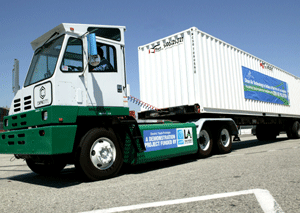
(Photo: B. Samra)
GELLERMAN: It’s Living on Earth. I’m Bruce Gellerman. The Los Angeles seaport is the largest in the country. Cargo ships from Asia arrive laden with all variety of stuff from electronic devices to toys to clothes, all packed in steel containers. Giant cranes then load the containers onto tractor trailer trucks, which haul them away. These heavy trucks are a major source of soot, or ‘particles,’ in the LA region. But soon the port will clean up its act when twenty-five all-electric trucks arrive.
The electric trucks won’t just help reduce air pollution. As Living on Earth's Ingrid Lobet reports, officials predict they could spark a change in seaports around the world.
[TRUCK ENGINE RUNNING]
LOBET: Forty-thousand times a day, heavy diesel rigs scurry in, out and around the port of Los Angeles, picking up, dropping off and just waiting around, idling. Dirty air and noise are two of neighbors’ and workers’ main complaints about the port, so when David Freeman became chief of the Harbor Commission two years ago, he took on these issues with zeal.
FREEMAN: When I got here on this commission, I was handed this report that said we’re gonna cut pollution in half, back to what it was in 2001. And I looked at the report, and it said that we’re now causing thirty-five hundred premature deaths. And I said well, half of that is seventeen hundred fifty people. We can’t kill seventeen hundred fifty people. We have to have a standard of reaching healthy air.
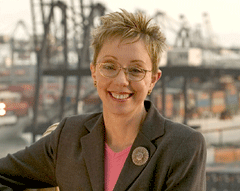
Dr. Geraldine Knatz is Executive Director of the Port of Los Angeles. (Courtesy of the Port)
FREEMAN: We’ve been told by the experts that whether it’s LNG or biodiesel – whatever you burn – if you burn something you’re gonna have a tiny, small particulate matter. And these folks are right there at lung-level breathing that stuff. So to have a vehicle that will not burn anything that will just be run on electricity is a fundamental cleanup. This is not show; this is really tell.
[GEARS CLICK IN PLACE; MAN SAYS ‘LET’S START IT UP HERE’; ELECTRIC TRUCK ENGINE WHIRS ON]
FLUEGAL: A lot quieter than your standard diesel truck, huh? Yeah, it's real nice.
[ELECTRIC TRUCK RUNNING]
LOBET: Michael Fluegal is a vocational laborer at the port and drives a lot of heavy equipment.
FLUEGAL: We're real proud of it. When I got involved with the truck myself, you know, I had my doubts. But we’ve threw everything but the kitchen sink at it and it just keeps performing, so it’s just short of spectacular. It’s – we've hauled as much as sixty-eight thousand pounds on this truck, and it just keeps on ticking.
[TRUCK DECELERATES; POWERS DOWN AND SWITCHES OFF]
LOBET: Experts agree running a vehicle on electricity, even when half of it comes from coal, as here, is much cleaner than burning diesel. But David Freeman says the port plans to run the truck on solar, and already has the first megawatt out to bid.
The person who shepherded this project from ‘let's do it’ to ‘here it is!’ is Balwinder Samra. He's an electric vehicle expert who helped golf carts go electric, and sold electric delivery trucks in Mexico. He remembers when electric forklifts were new.
SAMRA: I still remember customers use to not believe us when we would go in and say this one is electric. And I was very surprised, once the economic analysis got around, that industry switched very fast.
LOBET: Samra was struck by how short the hauling distances were at the port, usually less than twenty-five miles to regional warehouses and railroad connections, and often less than half a mile from one spot in the port to another.
SAMRA: It was a ideal opportunity for electric vehicles.
LOBET: And with the cost of diesel skyrocketing, the timing seemed right, too. The electric trucks can cost seventy thousand dollars more than diesel trucks up front, but battery recharging saves money compared to fuel.
SAMRA: Just an example, if we tried to do this in 1980s, we had dollar-a-gallon type stuff so I would be right now telling you we can save you five thousand dollars a year. Not as compelling is it? Today, because of the pricing, we have a thirty-five thousand dollar argument, which at least perks up somebody's ears and they say let's talk about this more.
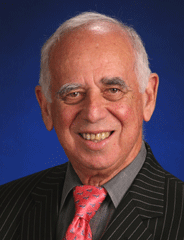
David Freeman heads the Los Angeles Harbor Commission. (Courtesy of the Port of Los Angeles)
LOBET: The team chose traditional lead-acid batteries for price and reliability. They hope a next-generation battery will increase charging speed and capacity. To keep the trucks operating, workers have to recharge them four hours at night, and also briefly during shift changes. They use a smart charger that can charge four vehicles at a time, and adjust the flow of juice to each one depending on need.
Samra's company, Balqon, is still working out the kinks in those distribution algorithms. He says when the frustrations of new-product development weigh him down, he remembers the reception the first truck got from port employees.
SAMRA: There were like twenty people whipping out their cell phones and trying to take the images of that thing. It was very exciting.
LOBET: Officials think half the eight thousand trucks needed at the port could be electric. That could potentially eliminate two hundred tons annually of one principal pollutant: NOx. Even before the Port of LA's electric trucks are announced, Samra says he's been deluged with calls.
SAMRA: A lot of interest from West coast ports, Canada, Italy, Pacific Asia. There’s a lot of people calling us. It just seems like a lot of people were waiting for this to happen.
LOBET: Over the last decade the southern California seaports have been shaken by their reputation as the largest polluters in the nation's most polluted region. Angry communities have sued and shut down nearly all port expansion. Now the new leadership at the ports hopes they'll be able to do something that didn't seem possible a few years ago: expand, and get much cleaner, at the same time.
For Living on Earth, I’m Ingrid Lobet in Los Angeles.
[HUM OF TRUCK ENGINE]
Related links:
- Electric Truck Manufacturer
- Community Blog on Clean Ports
- Port of Long Beach Green Port Policy
- Port of L.A. Clean Truck Program
Electric Dreams Could Come True

The Nissan Cube is an example of what Nissan’s electric fleet of vehicles will look like. (Photo: Sharon Yarbrough)
GELLERMAN: Nissan motor company has announced plans that could leave other car companies eating its dust. The Japanese automaker says it’s coming out with a whole fleet of plug-in electric vehicles that will put a smile on your face as you buzz past gas stations. John O’Dell is senior editor of the auto website greencaradvisor.com and he joins me on the line. Hi, John. Thanks for joining us!
O’DELL: Well, thank you much for having me. Appreciate it.
GELLERMAN: So what does Nissan have up its sleeve?
O’DELL: If we knew that we’d be writing tons of copy. What we do know is that the company has said in the past that it will launch a commercially viable all-electric, which means battery-electric, car in the United States in 2010. They’ve sort of signed it in to concrete now. It’s official, it’s part of Nissan’s new five-year plan. Carlos Ghosn went public with that the other day.
GELLERMAN: He’s the, he’s the head of Nissan.
O’DELL: The head of Nissan and of its French partner and co-owner, Renault. But in any event, he’s gone past the point of no return. He’s made a global promise to do this, and it would be pretty embarrassing for the company if they weren’t able to follow up on it.
GELLERMAN: So they’re playing it close to their chest. We don’t really know what these cars are gonna look like?
O’DELL: We have an idea. They showed a car at the New York auto show earlier this year that they said would provide a lot of clues, and that car was a modified version of a vehicle that is a big seller over in Japan called the Nissan cube. You could say it’s a Nissan version of the Scion xB – a very boxy – it looks sort of like a refrigerator box on wheels.
GELLERMAN: And they’re gonna have more than just this boxy cube?
O’DELL: Yes. Ghosn has said that he intends to have – you have to remember, the man’s French – sexy cars, with electric power. So we’re expecting to see sedans, sports coupe and more utilitarian vehicles as well.
GELLERMAN: You know, Mr. O’Dell, if there’s a plug-in electric car in my future, in your future, where’s all that electricity coming from?
O’DELL: Well, there’s a debate about that. One operating theory is that most people would be using the vehicles during the day and recharging at night when demand for power is relatively nil compared to what it is on a hot afternoon.

The Nissan Cube is an example of what Nissan’s electric fleet of vehicles will look like. (Photo: Sharon Yabrough)
O’DELL: Correct, yeah, there’s no free lunch. When you’re making electricity, you’re producing CO2 and other emissions, and in some places it’s cleaner than others. Power plants that burn coal are relatively dirty, even if the coal’s relatively clean. They’re a lot dirtier than plans that generate power from natural gas, hydroelectric, wind. Yeah, we’re going to see a – a slow revolution in this country, but a revolution nonetheless in how we generate power and how we use it.
GELLERMAN: With all these drivers in the future pulling up and plugging in, do we have the grid infrastructure to handle this much of a demand of electricity?
O’DELL: The theory is that yes, we do, and we’re not talking about putting ten million electric cars on the road tomorrow. We’re talking about hundreds, and then thousands, and then tens of thousands, and it’s going to give the electricity providers time to build up what they need to build up. One of the things that’s still sorely lacking – and it’s the case with all alternative fuels – is a national infrastructure so that you can get in the vehicle and drive it from, you know, here to there and have fuel everywhere you’re at.
GELLERMAN: We have a company here near Boston called A123. They make batteries, and they can get what one hundred sixty thousand miles, they say, without any gas.
O’DELL: Oh yes, it’s doable. Electric cars existed before gasoline cars almost, and at one time there were more electric cars on the roads in the U.S. than there were anything else, back in the nineteen-tens and twelves. But to make them reliable, to make them run the way we expect our cars to run, is still a challenge. But yeah, a hundred, two hundred miles on batteries, zero tailpipe emissions – it’s all possible, it’s – and we’re gonna see it. It will be coming.
GELLERMAN: So back to the future.
O’DELL: And faster than a lot of us used to think.
GELLERMAN: John O’Dell is senior editor of the website greencaradvisor.com, part of the Edmunds’ family of auto information sites. Mr. O’Dell, thank you very much.
O’DELL: I appreciate the opportunity to speak with you and your audience.
GELLERMAN: Happy motoring.
O’DELL: Thank you.
Related links:
- Green Car Advisor Website
- Nissan’s Home page
Michael Recycle
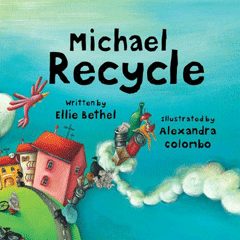
[MUSIC: The Adventures Of Superman (TV Theme)]
GELLERMAN: Look, up in the sky, it’s a bird, it’s a plane! No, it’s…Michael Recycle. Faster than a speeding windmill, able to leap stinking garbage dumps in a single bound, crush plastic with his bare hands – Michael Recycle is showing kids how to recycle one rhyme at a time.
He’s the superhero in a new book by Ellie Bethel. We challenged Michael Recycle to a tough test – nine year-old bookworm Anna Carton-Smith.
CARTON-SMITH: The big picture is that there’s a town that doesn’t know how to recycle or doesn’t know how to reuse things, or how to not pollute everything and stuff, so when this guy comes, named Michael, he likes to I guess help people in recycling so he tells them how they could help, and then they try to do it and they accomplish a lot.

Anna Carton-Smith reviewed “Michael Recycle” for Living on Earth. (Photo: Eileen Bolinsky)
CARTON-SMITH: Well, I think it would be really fun for five, six, seven and probably eight, but like it doesn’t mean that like my age or older people might not like it, too, it’s just that I think that would be a very good age to read this book.
GELLERMAN: Well let’s read something here from the book and see what it sounds like, ok?
CARTON-SMITH: Okay.
There once was a town called Abberdoo-Rimey
Where the garbage was left to rotten and slimy.
It never smelled fresh. The air was all hazy
But people did nothing. They got rather lazy.
GELLERMAN: Would you like to live in Abberdoo-Rimey?
CARTON-SMITH: Not at first.
GELLERMAN: How come?
CARTON-SMITH: Because it’s all filthy. And nobody – everybody litters, and it’s – gross.
GELLERMAN: What do you think of the rhymes?
CARTON-SMITH: I think it’s really cool how they rhymed it, and it’s really, like, smart, and how everything fits together.
And then something happened that none could explain.
It wasn’t a bird and it wasn’t a plane.
A green-caped crusader soared through the air,
With a colander hat on top of his hair.
I’m Michael Recycle! And I have a plan!
But I need your help – everyone to a man.
The sky and the river are smelly and brown.
Soon fifty-foot bugs will take over your town!
You’ve got to recycle! You’ve got to act soon!
Before all your trash reaches to the moon!
GELLERMAN: Don’t you know all about recycling now? I mean you’re nine years old.
CARTON-SMITH: Yes, like you can recycle, like, old food and make it dirt.
GELLERMAN: Isn’t that smelly?
CARTON-SMITH: It’s smelly, but it helps.
GELLERMAN: Yeah? How does it help?
CARTON-SMITH: It helps the dirt and soil and, I guess the worms, I guess. (laughs)
GELLERMAN: So why do you need a book to tell you about recycling?
CARTON-SMITH: Well, it’s just also fun. So say I was nine years old and I didn’t know, this would help me a lot. But even if I do know, then it’d still be really fun.

Anna Carton-Smith reads from “Michael Recycle” with host Bruce Gellerman. (Photo: Eileen Bolinsky)
CARTON-SMITH: Yes.
GELLERMAN: You really do – you don’t ever throw away plastic stuff, and...
CARTON-SMITH: Maybe I do sometimes, but I do recycle a lot.
GELLERMAN: Okay, and now let’s go all the way back to here.
CARTON-SMITH: Ah.
GELLERMAN: There you go.
CARTON-SMITH:
Then he crunched a can. He gave them a wink.
And vanished from sight before they could blink!
So if you should see a green silhouette
streaking the skies, please don’t get upset.
The noise you hear – that clunk and that thunk –
It’s just our friend Michael, recycling old junk!
GELLERMAN: (chuckles) You know what I like about this picture?
CARTON-SMITH: The guy’s like, uh – I think he’s singing.
GELLERMAN: No he’s screaming. He’s got like, his tonsils are hanging out. (laughs)
CARTON-SMITH: (laughs)
GELLERMAN: Do you have a brother or a sister? A younger brother or a sister?
CARTON-SMITH: Yes, I have a brother.
GELLERMAN: How old is he?
CARTON-SMITH: He’s six, almost seven.
GELLERMAN: Would you want him to read this?
CARTON-SMITH: Yeah, I would, because then it would show him to recycle and stuff, because he doesn’t know a lot about it, but still.
GELLERMAN: Do you think – what do you think, is it important to have books about recycling or – you already knew this stuff. I mean, here you are composting, and you –
CARTON-SMITH: Well, I, well I think that this book is important to maybe probably people who don’t recycle as much, and it can show them that you should start recycling to make it better for the world. But like, it reminds me, too, again to just keep doing that, and, yea.
GELLERMAN: Well, Anna, it was a pleasure. I really enjoyed it.
CARTON-SMITH: I did too.
GELLERMAN: Anna Carton-Smith is nine years old and lives in Somerville, Massachusetts. The book is ‘Michael Recycle’ by Ellie Bethel.
Related link:
“Michael Recycle” by Ellie Bethel, IDW Publishing
[MUSIC: R.E.M. “Superman” from ‘Life’s Rich Pageant’ (Null Records – 1998)]
GELLERMAN: On the next Living on Earth – what’s living on Mars? Scientists will soon find out.
KOUNAVES: We’re looking for microbial life. We don’t expect to find little things scurrying around Mars or anywhere in the solar system. What we’re hoping to find, like in the dry valleys, is simple, microbial life that has evolved and survived for billions of years.
GELLERMAN: Pity – I was hoping for little green men on the red planet. Join us for the flight of the Phoenix Mars mission on the next Living on Earth.
[EARTHEAR: Eloisa Matheu “Mata Atlantica: San Pedro After The Rain” from ‘Brazilian Soundscapes’ (Sittelle Records – 1993)]
GELLERMAN: We leave you this week in a Brazilian forest.
After a few days of heavy rain, the Mata Atlantica forest is dripping. This biologically diverse habitat has many species found nowhere else, and is one of the most threatened forests in the world. Eloisa Matheu recorded the piercing calls of the Ant Thrush, joined by the Red-breasted Toucan and a Piping Guan.
GELLERMAN: Living on Earth is produced by the World Media Foundation. Our crew includes Ashley Ahearn, Bobby Bascomb, Eileen Bolinsky, Ingrid Lobet, Helen Palmer, Mitra Taj and Jeff Young, with help from Jennifer Baessler, Sarah Calkins, and Oregon Public Broadcasting.
Our interns are Annie Jia and Margaret Rossano. Jeff Turton is our technical director. Alison Lirish Dean composed our themes. You can find us at l-o-e dot org. Steve Curwood is our executive producer. I'm Bruce Gellerman. Thanks for listening.
ANNOUNCER: Funding for Living on Earth comes from the National Science Foundation, supporting coverage of emerging science, and Stonyfield Farm: organic yogurt and smoothies. Stonyfield pays its farmers not to use artificial growth hormones on their cows. Details at stonyfield.com. Support also comes from you our listeners, the Ford Foundation, the Town Creek Foundation, the Oak Foundation supporting coverage of climate change and marine issues and Pax World Mutual Funds: socially and environmentally sustainable investing. Pax World: for tomorrow. On the web at paxworld.com.
ANNOUNCER 2: PRI: Public Radio International.
Living on Earth wants to hear from you!
Living on Earth
62 Calef Highway, Suite 212
Lee, NH 03861
Telephone: 617-287-4121
E-mail: comments@loe.org
Newsletter [Click here]
Donate to Living on Earth!
Living on Earth is an independent media program and relies entirely on contributions from listeners and institutions supporting public service. Please donate now to preserve an independent environmental voice.
NewsletterLiving on Earth offers a weekly delivery of the show's rundown to your mailbox. Sign up for our newsletter today!
 Sailors For The Sea: Be the change you want to sea.
Sailors For The Sea: Be the change you want to sea.
 The Grantham Foundation for the Protection of the Environment: Committed to protecting and improving the health of the global environment.
The Grantham Foundation for the Protection of the Environment: Committed to protecting and improving the health of the global environment.
 Contribute to Living on Earth and receive, as our gift to you, an archival print of one of Mark Seth Lender's extraordinary wildlife photographs. Follow the link to see Mark's current collection of photographs.
Contribute to Living on Earth and receive, as our gift to you, an archival print of one of Mark Seth Lender's extraordinary wildlife photographs. Follow the link to see Mark's current collection of photographs.
 Buy a signed copy of Mark Seth Lender's book Smeagull the Seagull & support Living on Earth
Buy a signed copy of Mark Seth Lender's book Smeagull the Seagull & support Living on Earth

